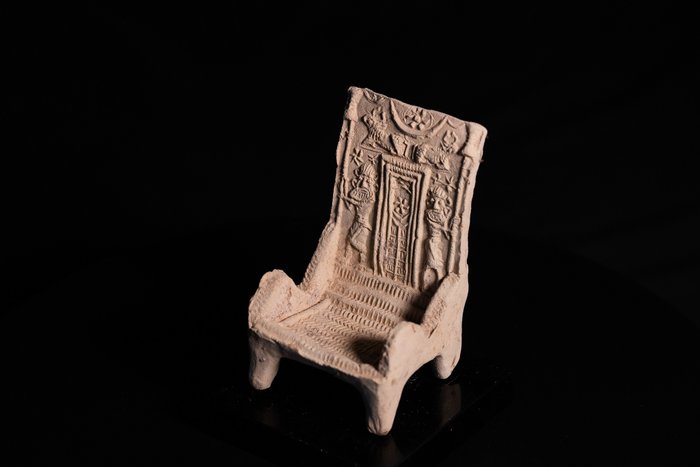
Mesopotámico Alabastro Dile a Brak Eye Idol - 82 mm
N.º 84937219

N.º 84937219

This is a unique item, as there are very few similar to this throne, and none of this quality. It is a model of a Mesopotamian throne, probably dedicated to the lunar god Sin. Above the seat, three steps lead to a closed door decorated with bands and stars, surrounded by two bearded heroes with hair forming four curls, holding long rods ending in lateral rings. Above the door, two bulls under three crescent moons and a star, iconography associated with the lunar god Sin.
For the Sumerians, he was known as Nanna or Nannar, son of Enlil, god of the wind and sky, and Ninlil, goddess of the air. Sin was his name in Akkadian and Babylonian. He was common- ly designated as En-zu, meaning 'Lord of wisdom'.
He is considered to be a very ancient god protector of shepherds. During the period when Ur exercised supremacy over the Euphrates valley (between c. 2600 and 2400 BC), Sin was natu- rally regarded as the supreme god of the pantheon. It is then that he was designated as "father of the gods", "chief of the gods" or "creator of all things". The "wisdom" personified by the lunar god is also an expression of the existing science of astronomy or the practice of astrology, in which the observation of the phases of the moon was an important factor.
Nannar/Sin was depicted as an old man with horns and a lapis lazuli beard, riding a winged bull. His main symbol was the lunar crescent, but also the bull, which came from his father, Enlil, "Bull of Heaven", and the tripod (which could be a candlestick)
In the British Museum we can find relatively similar examples of chairs (in a much worse state of preservation) that were found in Diqdiqqah, a district of the city of Ur where numerous deposits were found with votive terracotta sculptures, amulets and terracotta recreations of different types of furniture including thrones and beds.
Provenance: Belgian private collection Mr.Y.P. before 1981 / Galerie Gilgamesh, Archeologie Mediterraneenne & Orientale, France, 2015
*Exhibited: Ifergan Collection, Málaga (2018-2020)
*Attached thermoluminescence test (TL)
Statement seen by Catawiki. The seller guarantees that he is entitled to ship this lot. The seller will take care that any necessary permits will be arranged. The seller will inform the buyer about this if this takes more than a few days.
According to Spanish legislation, items sent outside the European Union are subject to export taxes and will be added to the invoice, at the buyer's expense.
These export fees are fixed on the final auction price and the tax rate is not applied directly on the total value of the item to be exported, but rather the different percentages by sections are applied to it:
- Up to 6,000 euros: 5%.
- From 6.001 to 60.000 euros: 10%.
Due to customs regulations about antiques, this lot cannot be sold to customers residing in United States or Switzerland.
Cómo comprar en Catawiki
1. Descubre algo especial
2. Haz la puja más alta
3. Paga de manera segura